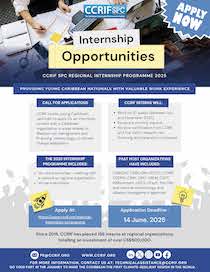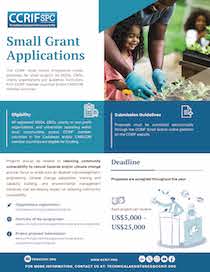The 2019 Atlantic Hurricane Season will officially begin June 1 and end November 30. According to researchers at Colorado State University, 13 named storms are forecast this hurricane season, five of which are expected to reach hurricane status, with two of the hurricanes forecast to reach “major hurricane strength” of Category 3 to 5, or winds of 111 mph or greater. This hurricane season is predicted to be slightly below normal as a result of a current weak El Niño event which continues to persist and perhaps strengthen over the summer and fall months. Also, sea surface temperatures appear to be slightly below normal.
In 2018, CCRIF made payouts totalling US$8.3 million to 2 members: Barbados after Tropical Storm Kirk and Trinidad and Tobago after a rainfall event in October. But 2017 was a particularly devastating year for the Caribbean and a defining moment for the Caribbean after suffering the devastation caused by two category 5 hurricanes within 14 days of each other. Damage and loss due to these storms were estimated at approximately US$130 billion and affected 18 countries, their populations and social and economic infrastructure. These catastrophic events resulted in CARICOM declaring its ambition to become the first climate-resilient zone in the world. Following Tropical Cyclones Maria and Irma, CCRIF made payouts totalling US$55 million to 9 member governments.
HURRICANE CHECKLIST
Whilst this checklist is most appropriate for organizations, it can be utilized at the household level.
Whilst this checklist is most appropriate for organizations, it can be utilized at the household level.
BEFORE THE HURRICANE SEASON
- Ensure all staff are aware of the contents of the hurricane response section of the Disaster and Emergency Response Contingency / Management Plan and know their roles and responsibilities
- Know the terminology associated with hurricanes (watch, warning)
- Do an inventory of hurricane supplies
- Identify the nearest shelter
- Check the storm surge history and elevation of your area.
- Know your local disaster coordinator
- Ensure insurance policies (home, office etc) are up to date and have adequate coverage
AT THE START OF THE HURRICANE SEASON
- Check on inventory. Items should include water boots, raincoats, flashlights, batteries, radio, hurricane lamp, hurricane shutters, hooks and latches, plastic bags, nails, rope and matches
- Trim trees with branches next to buildings and electrical lines
- Ensure that there adequate drinking water supplies and storage facilities for water (barrels, tanks)
- Check on insurance coverage and ensure that it is appropriate for your facility and equipment
- Stock 4-5 days' supply of food that does not need cooking
- Know where emergency centres are (e.g infirmaries, hospitals, police stations etc.)
- Ensure that there are first aid supplies
- All hurricane supplies must be properly stored and marked
- Develop an Emergency Contact List for all essential employees
- Identify vital records and make back-up copies and ensure cloud storage. Identify a safe storage level within the facility for record storage where they can be relocated to if necessary. This area should be above ground level and away from windows and exterior walls which may leak. Consider moving vulnerable records off-site if the agency is located in a storm-surge prone area.
- Determine responsibility for maintaining the facility. Ensure that the following are addressed:
- Patch roof and windows
- Check security and flood lighting
- Identify emergency power requirements. If a generator is not available rent or purchase one and test every month during the hurricane season
- Determine whether computer support will need to be available for during a hurricane
- Verify that communications equipment is operational
BEFORE THE HURRICANE
- Listen to all warnings and bulletins via radio or television or social media platforms
- Procure extra food if you have not already done so
- Fill vehicle(s) with petrol and place vehicles on high ground preferably in a garage or other shelter
- Store at least half a gallon of drinking water per person per day. Remove all wall items and hanging articles
- Secure and cover all equipment such as computers with plastic/garbage bags
- Ensure that all items on the outside that can be blown away are secured or placed inside
- Identify and protect vital records such as accounts, receipts, customer records, tax records and other personnel and administrative documents. These maybe placed in storage cabinets or wrapped in plastic. If necessary, temporarily relocate to an off-site storage facility.
- Store chemicals, fertilizers and other toxic materials in a safe section of the building in waterproof containers.
- Ensure that roofing is secured and remove from compound all loose objects which might cause damage during strong winds.
- Tape all glass windows and showcases to secure them. If your building has extensive glass frontage, clear out that section of the building as much as possible and use shutters to protect the glass. If shutters are not available strong masking tape should be used to tape "X" across the glass to prevent splinters from scattering in case the glass shatters.
- Secure all furniture and equipment above water level, battening doors firmly and securing shutters especially if business is located in flood prone areas.
- Move heavy duty equipment to a safe location
- Dismiss essential employees temporarily so they can secure their own homes and property before returning to duty.
If the hurricane continues on its path and a hurricane warning is put into effect additional measures should be taken by the organization. These include:
- Removing all outdoor hazards - e.g. hanging signs.
- Releasing non-essential staff to prepare their homes.
- Wrapping office equipment such as copy machines and computers in plastic to protect against damage.
- Moving desk, files, equipment and furniture away from windows without shutters to on area where they will be safe.
- Disconnecting electrical equipment, turning off lights and all air conditioners
DURING THE HURRICANE
- Assume a calm posture
- Continue to listen to the radio for reports and where possible social media platforms
- Do not go outside unless absolutely necessary
- Do not open windows and doors which are exposed to the full forces of the wind
- Use the brief time during the eye of the hurricane to effect any repairs for safety
AFTER THE HURRICANE
- Clear up debris and effect emergency repairs
- Do not touch loose or dangling wires
- Remove shutters and store
- Boil all drinking water for at least 10 minutes
- Protect yourself before going outside
- Do not empty any water stored until safe drinking water is restored
- Check for damage to structure of facility and equipment
- Report any damage of water or sewer mains or electricity poles to local authorities, report any damage to office or facilities to relevant personnel in your organisation





